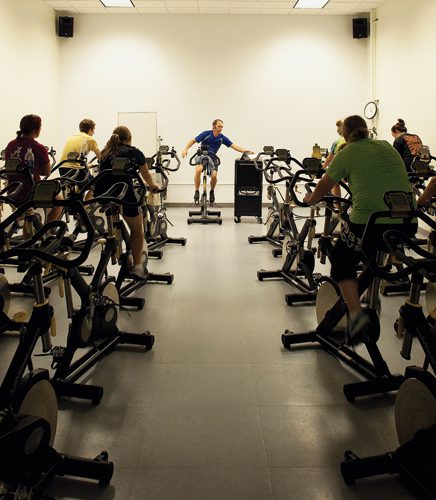A new BYU program gets hearts—and minds—pumping.
A 40-foot Ferris wheel spun outside the Harris Fine Arts Center, bright blue banners between its spokes heralding Student Wellness. Nearby, beneath giant balloons with labels like “Social” and “Physical,” students swarmed club booths to register their interests in everything from Brazilian jiujitsu to environmental science.
At the annual Involvapalooza in early September, the new Student Wellness program promoted a host of resources. These were organized into eight categories, as announced on the balloons: career, physical, spiritual, social, emotional, financial, intellectual, and environmental.

A Richards Building racquetball court has been transformed into a spinning room, complete with 40 cycles.
Larry T. Hall (BS ’70), director of Student Wellness and an exercise sciences professor, says the program will help students develop foundations for a well-rounded life. “This is a very formative time in a person’s life. . . .There are a lot of things involved in a balanced, happy, successful life,” he says.
Two years ago BYU dissolved the general-education wellness requirement that obligated students to take health and physical-education classes. But even as it did so, the university indicated its desire to encourage a broader view of student wellness.
Thus began a two-year effort to examine student wellness and formulate a new program. A study revealed that the bulk of students were minimally aware of campus wellness services.
“BYU has a tremendous number of programs, services, opportunities for students,” says Hall, “but this was fairly convoluted within the university, and students didn’t often learn of opportunities until late in their academiccareers.”
At the center of the new wellness program is the Student Wellness website, organized by the eight areas of wellness, with calendars of activities and menus of available resources, from internships to tax help to nutrition guidance to date ideas. While few of the resources are actually new, the website provides a much-needed hub.
Hall says the strengths of the new program lie in its breadth and in the way it makes students responsible for their behavior. “In the real world, these students will need to make good life choices in a number of important wellness areas,” Hall says, “and we’re hopeful this initiative will help them develop some of these critical decision-making skills.”
And students are stepping up to the plate. When the university removed the wellness requirement, administrators expected enrollment in activity classes to drop. However, student interest has remained strong, with more than 10,000 students enrolled every year. And in fall 2011 BYU added its first-ever activity classes in yoga, pilates, spinning, and zumba.
Under the direction and design of Larry F. Neal (BS ’89), the university has also created the Student Fitness Center and a spinning room. The fitness center expanded the size of the Smith Fieldhouse’s student weight rooms by 50 percent and is now open for student recreational use anytime between 6 a.m. and 10 p.m. Student interns will serve as fitness and nutritional coaches at the center.
The new program reflects the university’s holistic view of education, says Janet S. Scharman, student life vice president: “Sometimes students come to the university and get so focused on their academics they forget about the whole person. . . . We’re educating the whole individual.”









